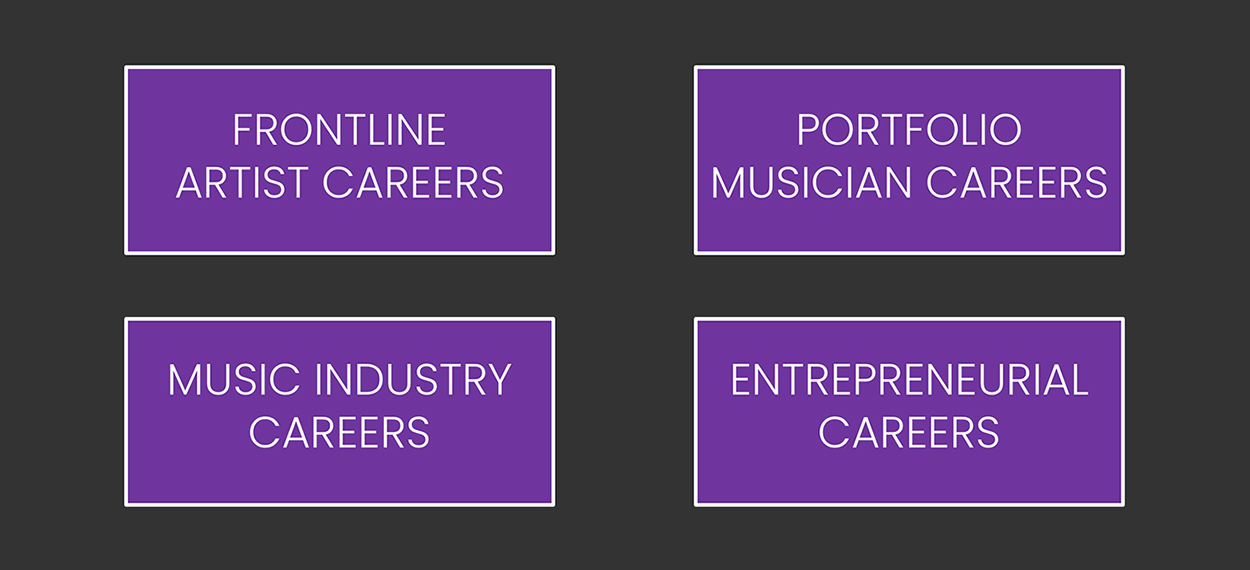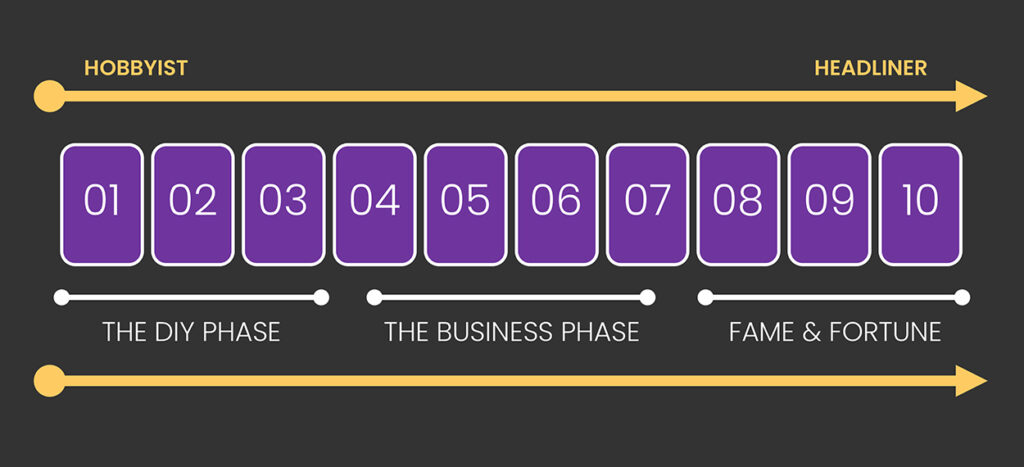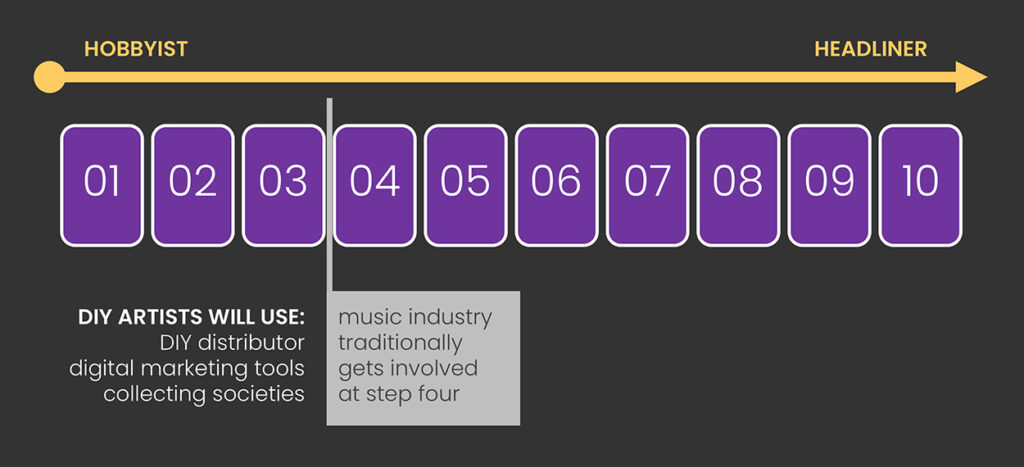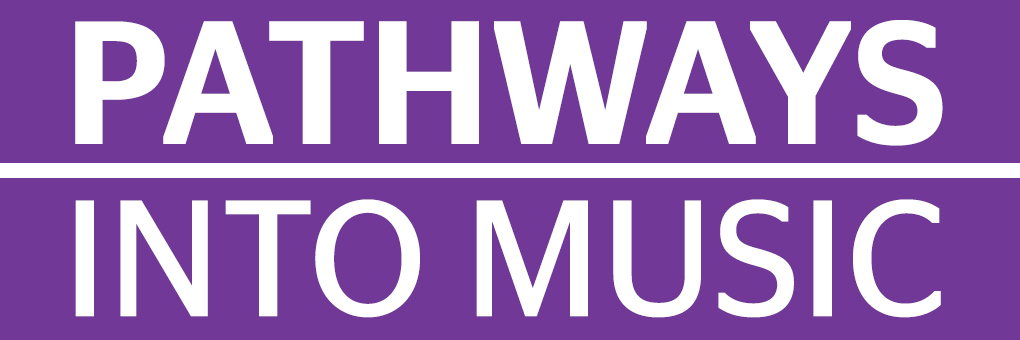This website uses cookies so that we can provide you with the best user experience possible. Cookie information is stored in your browser and performs functions such as recognising you when you return to our website and helping our team to understand which sections of the website you find most interesting and useful.
Pathways Into Music Research
Mapping music careers
Published in February 2020
The Pathways Into Music Foundation has been mapping music careers, to help those who aspire to work in music – and the educators and organisations that support them – to better understand the different pathways and how they work.

TYPES OF MUSIC CAREERS
There are a number of different kinds of careers in music.


The frontline artist career: music-makers who release their own music and become – in one form or another – a consumer-facing brand. A frontline artist usually operates their own artist business that generates income from both the music and the brand. The frontline artist may be a solo act, or may be part of a group, band or collective.

The portfolio musician career: those music-makers who compose, produce and/or perform music with and for frontline artists and/or companies and organisations that commission original works. Portfolio musicians usually work on an assortment of projects at any one time, hence the name.

The music industry career: people who work on business side of music, usually providing services to frontline artist businesses. These may be employees of music industry companies, or they may run their own companies, or they may also have a portfolio career working on a freelance basis on various industry projects at any one time.

The music entrepreneur career: people who seek to set up new businesses supporting frontline artists or the wider music industry, sometimes by developing new technologies or approaches that seek to disrupt music business norms.

Of course, these different categories of music career do not exist in isolation. Some people may fit into more than one of these categories at any one time, or they may begin as a frontline artist, become a portfolio musician, and then move into a music industry career. Or some other combination of the different career pathways.

However, to help people better navigate and understand music careers, it is useful to make these distinctions, and to then map each career type, to identify the common pathways that people take as a frontline artist, a portfolio musician, a music industry executive and a music entrepreneur.

MAPPING THE FRONTLINE ARTIST CAREER
We have begun by mapping the career of a frontline artist. Every artist – and every artist business – is different, of course. However, there are common characteristics found in the journeys that most frontline artists take, and that is what we have sought to map.
As a starting point, imagine at one end of the scale you have a music-maker who is creating music at home or in the classroom – a hobbyist – and then imagine at the other end a superstar headlining major festivals and stadium venues – the headliner.
Then imagine there are ten steps from one to the other. That is how we have begun to map the frontline artist’s pathway into music. Let’s consider some key aspects of each stage in this ten step pathway.


STEP ONE
We begin with the hobbyist music-maker. At step one the frontline artist is making music in private. They aspire to turn their passion into a career, and/or to get their music beyond their classmates, friends and family to the wider world.
But they are only just embarking on that journey. Almost by definition, we don’t know who these people are, because they are yet to go public with their music.
At this stage the focus is on learning how to make, play, perform and record music. The step one artist is learning their craft, experimenting with the creative process, and identifying the kind of music they want to make and the kind of artist they want to be.
Much of this is probably happening informally and organically, as the music-maker is primarily focused on the simple enjoyment of making music.

STEP TWO
At step two the frontline artist is starting to share their music with the wider world. Locally this might mean playing their music live.
Initially at school or college shows, or by busking, or by taking part in open mic nights. Slowly they might to start stage their own parties, gigs or club nights in their local area.
Back home they’ll be making their early recordings on affordable kit and posting these to SoundCloud and YouTube.
More savvy artists will learn about and sign-up for the music industry’s collecting societies at this point. And will find the DIY distribution platforms that can help them get their music onto all the digital services.
They’ll also start to think about building a brand for their music-making and setting up social channels to communicate this brand.
As the work-load increases, and especially as the artist starts to need visual materials – photos, cover artwork, gig flyers, videos – the budding frontline artist needs to start networking and collaborating with other early-career creatives in their local area.
That includes other music-makers, but also budding visual artists, photographers, video-makers, event organisers and those with digital and social media skills.
On one level the frontline artist is still DIY. But on another level, they are part of a usually informal team of creative people that is greater than the sum of its parts.

STEP THREE
At around step three the frontline artist will probably start to have a clearer understanding of what kind of music they want to make and what kind of performance they like to stage, and also what kind of brand and persona they want to present to the wider world.
They will probably be playing live on a regular basis by now and will be increasingly looking for opportunities to play shows beyond their home town.
They will usually become more organised in the way they release music, so that they can stage small marketing campaigns around each new track or EP. And they will start to generate some income from their music-making, though much of this will probably be reinvested into the project.
Towards the end of step three music media and the music industry will likely start taking an interest, increasing the number of opportunities for the artist.

STEP FOUR
At around step four the frontline artist will start to connect more formally with the music industry, beyond the collecting societies and DIY distributors.
Managers, agents and lawyers are often the first traditional business partners to get involved, each bringing different areas of expertise, and working with artists in different ways.
Some DIY distributors are also now set up to work more proactively with those artists gaining momentum, either directly or through sister label or distribution companies. Some smaller independent labels may look to get involved on a short-term basis at this point, while bigger labels and publishers may also offer some initial development support.
These new business partners will usually open doors and bring new opportunities to the table. They will use their expertise, contacts and resources to better exploit data and deliver marketing campaigns, so to further grow the fanbase and identify new revenue streams.
The artist will probably now be playing live in multiple places, they will be starting to play festivals, including industry-focused showcase festivals, and may score support slots which will allow them to perform in front of and engage new audiences.
New releases will start to enjoy support from those media, playlisters and influencers who regularly champion new talent. This will also help bring the artist’s music to a wider audience: the big challenge being how to utilise that exposure to grow the fanbase.
More revenue will now be coming in, though a lot of that will still be reinvested into the project. More people will need paying at this stage too, though many of the business partners will be working on a commission basis, and will initially expect only nominal income from that commission.
Once a manager is on board, they will start the process of identifying and approaching other possible business partners, especially those who might advance money.

STEP FIVE
At around step five the frontline artist will start working with a wider range of business partners from within the music industry, with their manager identifying each new potential partner, negotiating deals – usually with support from the artist’s lawyer – and then managing the partnerships once the deals have been agreed and finalised.
Traditionally artists would look to sign conventional record and publishing deals with conventional labels and publishers at this stage, and in many cases they still do.
As well as allowing the artist to access an assortment of extra services and resources, these deals can also unlock cash for the artist, with labels and publishers advancing money that they will recoup from future income.
This is often important because, by this point, the artist will need to focus on their music full time and therefore give up the ‘day job’. But the artist’s business may not yet be bringing in enough profit to fund a full-time wage.
Record and publishing deals of this kind often involve giving up some control and some intellectual property, the general rule being the bigger the risk the business partner is taking, the more control they will want in return.
Some artists may actually choose to carry on self-releasing their recordings at this stage, but take a greater range of services from a music distributor than before, in return for which the distributor takes a bigger cut of future revenue. Some distributors may also advance cash at this stage.
Though going this route usually means both artist and manager have to take on some of the risk and some of the work that would otherwise be handled by a label.
On the live side, the artist will now be regularly touring, while also playing festivals and support slots. In part aided by the higher profile marketing campaigns that have been funded and led by a label, the artist will start to play the size of venues where live becomes profitable, especially in their home and/or strongest markets.

STEP SIX
By step six, the frontline artist will have most of their business partners in place, certainly in their home market. Things will be more financially secure, in the short term at least, and the artist will usually slip into a cycle of recording, releasing and playing live.
Depending on the artist and their fanbase, there will be an assortment of new opportunities to consider at this stage, often going well beyond music-making. The artist and their manager will need to consider what is appropriate creatively, and what offers both short and long-term benefits commercially.
The fanbase building process continues, although the focus may now be on new markets. In the digital age artists are, in theory, global from the off, and may organically find an audience in other countries much earlier in their career. However, being a truly global artist business will require focus and investment – and probably a new round of business partners – and this will become a priority for the artist’s core team at this stage.
Another focus for the manager in particular should be longevity. Many frontline artists will peak at step six. Which is fine, because the artist can make a living from their music at this point. But some of the revenues allowing that to happen will inevitably decline. Can other more sustainable revenues be found to replace them?

STEP SEVEN
At step seven the frontline artist and their team will start to really enjoy the economies of scale of the music industry. They will be doing many of the same things as a step six, but with a bigger audience in more markets the artist’s music-making will become more lucrative.
As things scale, new skills and expertise are required on the artist’s team. New business partners will be needed. But how do they fit in? While enjoying the many positives of running a successful artist business, there are still plenty more challenges to navigate.
Then there are the challenges and opportunities of becoming a celebrity. Social and digital channels have multiplied the commercial opportunities from this side of being a frontline artist, but have also increased the possible negative impact. The entire industry is still adapting to how they now need to support artists dealing with these challenges.

STEPS EIGHT TO TEN
In the final steps of our pathway the frontline artist is heading up a successful, profitable and increasingly global artist business. Although there remain challenges and difficult decisions to be made. And in music-making longevity is never guaranteed.
Artists may also increasingly want to make creative decisions which are not always commercially sensible, but which are nevertheless more fulfilling creatively speaking.
For the traditional music industry, this is where the big profits were made, and where those business partners who put in time and money earlier on in the artist’s journey saw a real return on investment, especially if they had secured IP ownership as part of their deals.
However, in always seeking to find the next step eight artist, some music companies – especially the bigger music companies – often failed to truly capitalise on the revenue earning potential of artists at steps six and seven.

THE ROLE OF THE MUSIC INDUSTRY
We have split the frontline artist’s pathway into music into three main phases:
The DIY Phase: steps one to three.
The Industry Phase: steps four to seven.
The Fame & Fortune Phase: steps eight to ten.
As described above, the traditional music industry usually only gets involved in a frontline artist’s career in a focused way around about step four.

DIY distributors work with artists much earlier than this, and savvy artists will usually join the music industry’s collecting societies around about steps two and three. But focused support from a manager, agent and lawyer, not to mention a label and publisher, usually comes later.
There are various reasons for this. For starters, there are many more early-career music-makers than there are people working with music-makers in a focused way. Also, working with an early-career music-maker can be labour intensive with no real short-term financial return.
So only part of the music industry wants to work with those at the very earliest stages of their career. And those that do, still want to see a certain amount of momentum building before getting involved, to reduce the risk of the investment they are about to make.
That is why we call the first phase of our pathway the ‘DIY Phase’. Even though to successfully build momentum the DIY artist will still need to form alliances with other creative people, which means that they are not truly doing it all themselves.
This DIY Phase – and how educators, policymakers, funders and the industry can better support music-makers during this phase – is the key focus of the Pathways Into Music project.

SUPPORT AT THE DIY PHASE
We have identified five key areas of support available to those early-career music-makers in the DIY Phase:

DIY SERVICES
There are an increasing number of usually online services to help early-career music-makers.
The most obvious is the DIY distributors that allow artists at any stage in their career to get their music onto all the key digital platforms and to earn royalties whenever their music is streamed.
Some of these companies also provide other add-on services and/or educational resources and events.

INDUSTRY ORGANISATIONS
Most of the music industry’s collecting societies and trade organisations – as well as some venues – have schemes and programmes to support new talent.
The collecting societies – PRS and PPL in the UK – can also help early-career music-makers collect royalties when their music is broadcast or performed in public.

PEERS
As mentioned above, although we call this the DIY Phase, an artist cannot actually progress by doing everything themselves.
Before engaging business partners and working with the music industry, early-career music-makers need to network and collaborate with other early-career creatives, including those with complementary skills and passions.
How easy this is will depend on where the music-maker lives and how much spare time they have. Those still in formal education often have an advantage in this domain.

MENTORS
Although the music industry only usually gets involved in a focused way at step four, it’s important to acknowledge the role of industry mentors in the latter part of the DIY Phase.
Of those artists who progress to step four, many will have been helped by one or more mentors from the wider music industry. Mentors may simply offer advice and open doors, or they may provide more formal support.
In the online age these mentors may offer their support from a far, but its perhaps most valuable when a mentor comes from the artist’s local music industry, which might include a local venue, studio or music shop.

EDUCATORS
Perhaps the most important area of support, especially at the start of the DIY Phase, comes from music educators.
Music educators are often the first people to see the talent and passion required to pursue a career in music, and have a direct line to the early-career music-maker to offer advice, knowledge and support.
A good music educator can also sign-post the other areas of support available, including the DIY services, the industry organisations, opportunities to collaborate with peers, and possible mentors in the local music industry.






